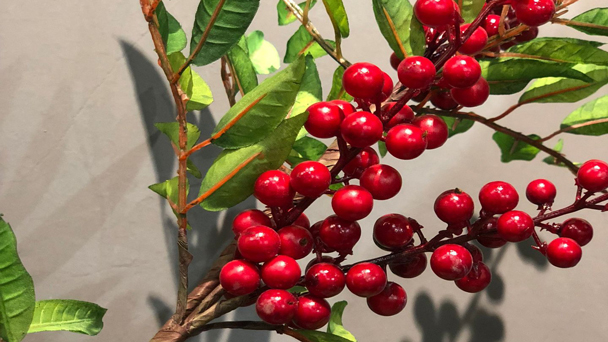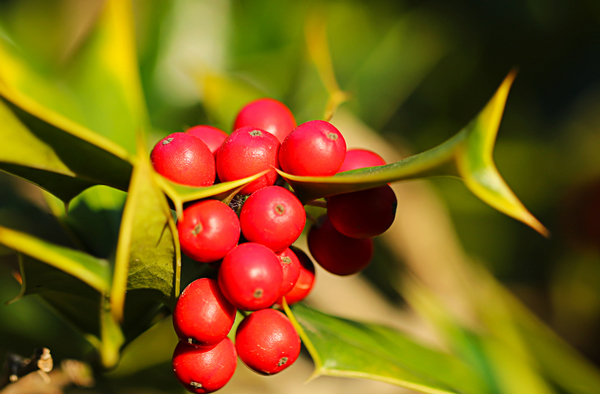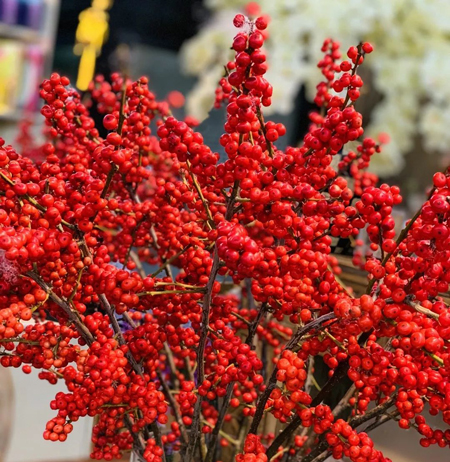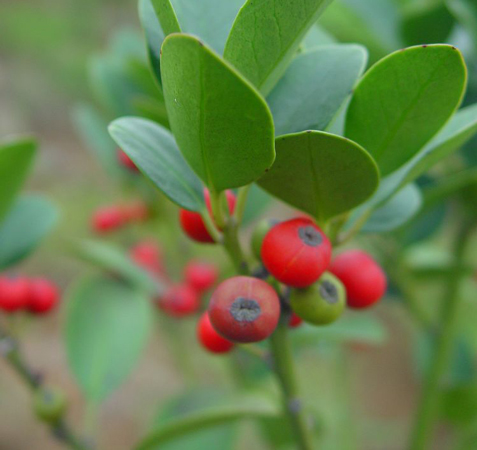Inkberry Holly (Ilex Glabra) Grow & Care Guide
Written by Iris
Nov 13 2021

Inkberry Holly (Ilex glabra) is a native compact shrub in the Aquifoliaceae that maintains leaves all year round. Inkberry Holly is a relatively slow-growing species that can grow up to 5-8 feet tall. Ilex Glabra sometimes forms clusters with many buds, making it an excellent plant for low hedges or borders. Inkberry Holly leaves are evergreen and toothed, reaching up to 2.5 inches. They are dark green and shiny on top and lighter and darker on the bottom.
Read More:
12 Wonderful Evergreen Shrubs for Your Garden
For hardwood cuttings, you should cut above and below the bud unions from the branches for best growth. If you want to use softwoods, cut about 0.24 inches (0.6 cm) below a leaf node.
Once this process is complete, dip the cut ends into rooting hormone then plant your cuttings in a mixture of potting soil and sand. Inkberry holly cuttings need a well-lit location and regular watering to develop a healthy root system. Once established, you can transplant each baby plant in its permanent spot.
In general gardening terms, pruning is probably the most misunderstood gardening chore, and certainly, the chore that is most likely neglected. When we specifically look at pruning Inkberry holly, this misunderstanding and negligence can be magnified.
Pruning has been described as a “combination of art and science.” I personally find pruning to be one of the most relaxing yet rewarding chores in the garden. Pruning a specific plant to look a specific way, involves art in creating a unique definition for a specific plant, and it involves science in understanding the physical growing habits of the plant to be pruned.

Compacta grows to 3 to 4 feet in height with a spread up to 6 feet. It has a tighter, more rounded growth habit than other forms.
Shamrock grows to 4 feet in height and spread. It has bright green foliage and is known to sucker less than other varieties.
Inkberry Holly Quick InfoHow to Grow Inkberry Holly (Ilex Glabra)Inkberry Holly Propagation with SeedsInkberry Holly Propagation with Wood CuttingsHow to Care for Inkberry Holly (Ilex Glabra)Inkberry Holly Light RequirementsInkberry Holly Soil CareInkberry Holly WateringInkberry Holly Temperature & Humidity CareInkberry Holly FertilizerPruning Inkberry HollyIlex Glabra Pests & Diseases CareIlex Glabra VarietiesInkberry Holly Care FAQHow tall does Inkberry Holly get?Is Ilex Glabra toxic?Is inkberry holly edible?
Inkberry Holly Quick Info
| Botanical/Scientific Name | Ilex glabra |
| Common Name | Inkberry holly, gallberry shrubs |
| Plant Type | Evergreen shrub |
| Light Requirements | Full sun to part shade |
| Soil Requirements | Moist well-drained soil |
| Bloom Time | Spring, Early Summer |
| Flower Color | Greenish white |
| Fruit Time | Early fall |
| Fruits | Pea-sized black fruits |
How to Grow Inkberry Holly (Ilex Glabra)
Inkberry Holly Propagation with Seeds
Each Inkberry Holly contains about four seeds. Growing inkberry holly from seed can be difficult as the seed germination is slow, requiring anywhere from sixteen months to three years. In addition, it can take another three years before the Inkberry Holly shrubs produce any flowers. A specialized coating to survive harsh winters protects holly seeds; however, this pulp-like substance also makes propagation more difficult. Nonetheless, growing Inkberry Holly shrubs from seed propagation can be done, with patience. Collect Inkberry Holly berries and break the skin off. Rinse the seeds in cold water and then plant them in soilless potting medium within a large flat. Cover the flats and place outdoors in a protected area over the winter. If all goes well, the Inkberry Holly seeds should germinate by spring. Otherwise, they'll have to remain through another winter.Read More:
12 Wonderful Evergreen Shrubs for Your Garden
Inkberry Holly Propagation with Wood Cuttings
Now, there are two types of Inkberry Holly cuttings that you can use for propagation. The most popular cuttings are those taken from hardwood growth during cold weather or their dormant period. However, you can also use softwood cuttings taken in summer or late autumn.For hardwood cuttings, you should cut above and below the bud unions from the branches for best growth. If you want to use softwoods, cut about 0.24 inches (0.6 cm) below a leaf node.
Once this process is complete, dip the cut ends into rooting hormone then plant your cuttings in a mixture of potting soil and sand. Inkberry holly cuttings need a well-lit location and regular watering to develop a healthy root system. Once established, you can transplant each baby plant in its permanent spot.

How to Care for Inkberry Holly (Ilex Glabra)
Inkberry Holly Light Requirements
Inkberry Holly shrub prefers full sun, especially in cooler climates. It can, however, tolerate partial sun and may appreciate some shade in warmer areas.Inkberry Holly Soil Care
Inkberry Holly is best planted in average, medium to wet soils and in full sun to part shade. It is adaptable to both light and heavy soils but does best in rich, consistently moist, acidic soils. It does not do well in alkaline soils. In native locations, it prefers sandy, acidic woodland soils and is often found along the edges of swamps and bogs.Inkberry Holly Watering
Inkberry Holly shrubs should be watered 1-2 times per week, depending on the weather. Trees do not require more watering, except in drought conditions where there is less than 1 inch of rain per week. Groundcover, however, should be watered 3 times per week for 3 months.Inkberry Holly Temperature & Humidity Care
Inkberry holly thrives in a wet, cool climate. This distinguishes it from other hollies, which often prefer drier locations.Inkberry Holly Fertilizer
Fertilize all your shrubs, evergreens, trees, groundcover, and perennials once every 3 weeks. This should be done during the months of April, May, June, July, and August.Pruning Inkberry Holly
Holly Inkberry is a shrub that should be pruned in the late spring to maintain the shape and height of the plant.In general gardening terms, pruning is probably the most misunderstood gardening chore, and certainly, the chore that is most likely neglected. When we specifically look at pruning Inkberry holly, this misunderstanding and negligence can be magnified.
Pruning has been described as a “combination of art and science.” I personally find pruning to be one of the most relaxing yet rewarding chores in the garden. Pruning a specific plant to look a specific way, involves art in creating a unique definition for a specific plant, and it involves science in understanding the physical growing habits of the plant to be pruned.

Ilex Glabra Pests & Diseases Care
- Leaf Spot
- Root Rots
- Cankers
- Pests

Ilex Glabra Varieties
Densa grows to 3 to 4 feet in height with a slightly greater width.Compacta grows to 3 to 4 feet in height with a spread up to 6 feet. It has a tighter, more rounded growth habit than other forms.
Shamrock grows to 4 feet in height and spread. It has bright green foliage and is known to sucker less than other varieties.

Inkberry Holly Care FAQ
How tall does Inkberry Holly get?
In the wild, inkberry holly is often found in bogs, but it grows just fine in typical garden soil. It's a broad spreading, semi-stoloniferous shrub 6 to 8 feet tall and 8 to 10 feet wide.Is Ilex Glabra toxic?
Warning: All Ilex species may be somewhat toxic if ingested. Sensitivity to a toxin varies with a person's age, weight, physical condition, and individual susceptibility. Children are most vulnerable because of their curiosity and small size.Is inkberry holly edible?
While the berries aren't edible for humans, many birds and small animals are fond of them in the winter. Growing inkberry holly in your yard is a simple project, as these plants are almost carefree.Latest Updated
- Benefits of Bugleweed - 7 Science-backed Health Benefits
- Bugleweed Dangers & Side Effects - Is It Poisonous?
- How to Plant Evergreen Trees - What You Should Know
- When to Plant Evergreens - Grow Guide for Evergreen Trees
- 12 Wonderful Evergreen Shrubs for Your Garden
- 12 Popular Evergreen Plants with Pictures for Beginners
- When And How To Prune A Lilac Bush Like a Pro
- How to Grow & Care for Lilac Vine (Hardenbergia Violacea)
- Japanese Lilac Tree (Syringa Reticulata) Care & Propagation Guide
- Shumard Oak Pros and Cons - What to Know
Popular Articles
- Winter maintenance of Antirrhinum Majus
- How to Grow Terminalia Mantaly Tree
- How to Grow and Care for Crossostephium Chinense
- How to grow Antirrhinum Majus in spring
- Peristeria Elata (Dove Orchid) Profile: Info & Care Guide
- Underwatered Snake Plant (Sansevieria Trifasciata) - Signs And How To Fix
- How to Care for Brazilian Jasmine Plant (Mandevilla Sanderi)
- How to Grow & Care for Graptopetalum Purple Delight in Summer
- Rosa Chinensis (China Rose): Plant Growing & Care Tips
- How to Care for Baby Sun Rose (Aptenia Cordifolia)